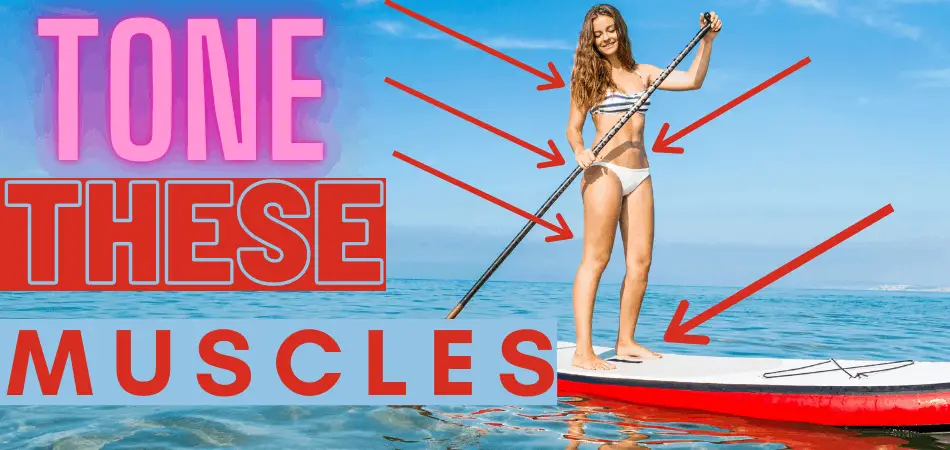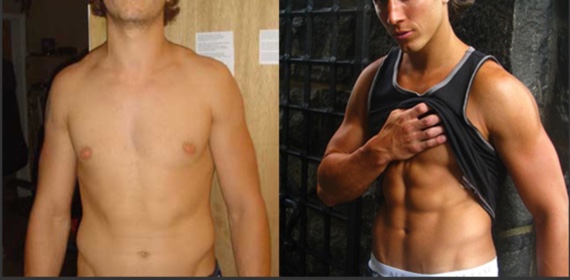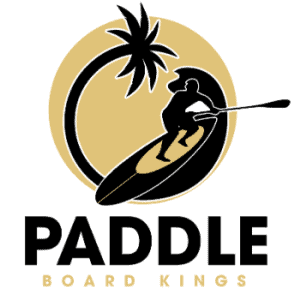
Wondering whether paddle boarding classifies as a workout? Can’t figure out which muscles you’re using and why you’re so sore afterward?
You’re in the right place!
I’m going to walk you through the muscles used in the various types of paddle boarding, whether you can get abs from the sport, and how to reduce soreness once you’re done for the day.
Let’s jump right into it!
What Muscles Does Paddle Boarding Tone?
When paddle boarding, you use all kinds of muscles regardless of whether you’re standing, kneeling, or in the prone position (i.e. lying down). Specifically, these muscles are what paddle boarding will tone and workout:
- Hamstrings
- Quadriceps
- Heart
- Diaphragm
- Traps and lats
- Biceps and triceps
- Rhomboid
- Abs
- Rotator cuffs
Of course, the muscles — and to what extent — you use will depend on the position you’re in.
When you’re standing up, your arms, back, shoulders, and abs will take the brunt of the work (trust me, you’ll feel it in the morning!) but your legs do come into play.
If you decide to switch to kneeling on your paddle board, you’ll feel the strain in your upper body. And finally, in the prone position, it’s your biceps and triceps that will feel most of the burn.
I’ll be talking about all of this in a lot of depth today. But before we get into the muscle side of things, I just wanted to have a quick discussion about calories.
How Many Calories Can You Burn When Paddle Boarding?
How Many Calories Can You Burn When Paddle Boarding? You can burn 250 to 1500 calories on average when paddle boarding.
Most water sports are fantastic for burning copious calories while getting that all-important thrill boost. However, defining the exact number of calories you can burn when paddle boarding is rather difficult. Why? Because it varies drastically depending on the person or type of paddling you’re doing.
Leisurely Pace
For those of you who like to take it slow, you can expect to burn between 305 and 430 calories. This number might have disappointed you but…
SUP Racing Speeds
If you decide to gather some speed and race, it will only take an hour to burn up to a whopping 1,125 calories! I think it’s fair to say that this is an impressive number.
SUP Surfing
SUP surfing is another fantastic way to burn calories quickly. You can plan to work off roughly 600 to 735 calories in an hour or so. Obviously, this does depend on how hard you’re pushing yourself.
SUP Yoga
Yoga in your living room burns a surprising number of calories. This figure only increases when you have the added challenge of staying upright on a paddle board. You can expect to burn around 410 to 540 depending on the speed of your yoga flow.
Okay, end of calorie discussion! Let’s get back to the muscle talk.
Muscles Used in Stand Up Paddle Boarding
I’ll start with stand up paddle boarding as it’s one of the most common disciplines. If you’re an avid paddle boarder, you know it’s no easy feat to hop on your board and stay dry — unless you’ve trained the correct muscles.
Core and Back
Weirdly enough, the main power source to your paddle boarding strokes should come from your core. If you’ve found yourself with overly aching arms after a few moments boarding, you’re probably not engaging your abs enough.
A high-quality SUP stroke comes from the slight twist and dip of your chest and shoulder to engage your obliques and abs.
This movement undoubtedly engages your back too. In turn, it takes some of the pressure off your arms and transfers it to your deltoids and traps. In my experience, you’ll need to keep your lower arm straight when you’re pulling the paddle to fully engage these muscles.
Arms
Your arms will be engaged throughout your paddle boarding session. But, most of the strain should be placed on your back and abs as I mentioned above since these are your upper body’s strongest muscle groups. I’ve always found myself fatiguing pretty quickly if I rely on my arms alone.
Shoulders
Your shoulders should act as your pivot point and should be engaged throughout your entire SUP workout. It’s important to note that they shouldn’t be the main power source (that’s your abs).
Having said that, you’ll still feel your shoulders working quite a bit due to the constant lift, dip, and pull motion.
Feet and Legs
As a beginner, I’ll bet money on the fact that you’re feet have cramped up at least a couple of times. Your feet have more than 100 muscles — tiny ones, granted — that you don’t really use in day-to-day life so when you start utilizing them, they have a bit of a freakout.
Don’t worry though, I promise this gets better!
Your legs play a big part in your SUP expeditions as, without them, you wouldn’t be able to balance or maintain your posture. Every stroke causes you to bend your knees. Thus, your lower calf, upper calf, quads, abductors, hamstrings, and glutes are working.
Muscles Used When in The Prone Paddle Boarding Position
Later on, we’re going to take a look at the differences between the muscles used in stand up paddle boarding and kneeling paddle boarding. For now, we’ll discuss the muscles you tend to use in the prone position.
Shoulders
When you’re lying down on your paddle board, you’re going to be using your shoulders a lot more than when you’re standing up.
This might seem strange but it’s because you need to keep your head lifted. In a perfect world, you’d keep it above your shoulders but this can get tiring very quickly!
If you are yet to give prone paddle boarding a try, I’d recommend heading out on a very short excursion before you try to tackle longer adventures. Otherwise, your neck and shoulders will be screaming.
Arms
You have to use your arms to propel you through the water when in the prone position. The movement will be tough on your triceps and biceps — so much so that if you do it regularly, you may well be quite the beefcake!
The constant muscle extensions and contractions are sure to tire you out (in a good way, I promise).
Back
You will need to engage your traps, lats, and rhomboids when you’re lying down on your paddle board to stabilize yourself. Plus, it will help you to keep your head up over longer journeys.
Does Stand Up Paddle Boarding Build Muscle?
Yes, Paddle Boarding does build muscles and is a great exercise to burn calories and help tone your body. As we’ve gathered by now, stand up paddle boarding — or any kind of paddle boarding for that matter — does use and strengthen a lot of targeted muscles.
However, if you are trying to grow large muscle mass similar to a body builder then paddle boarding isn’t necessarily the way to do it unless mixed with weight lifting.
This sport is great for you and it will tone your body and strip fat away. But it won’t build big, body builder-esque muscles, just leanness.
Why Building Muscle Mass Shouldn’t Be Your Main Concern When Paddle Boarding
I hope the fact that you won’t build huge biceps from paddle boarding hasn’t put you off. There are plenty of other health benefits aside from aesthetics that you can gain from kneeling, prone, and stand up adventures.
I’ll walk you through several of them now!
#1 Increases Your Abdominal Strength
I mentioned earlier how much your core is used in SUP trips. The muscles in your midriff are constantly engaged so it helps you to gain ab strength and lean tone.
Alongside this, your arms, shoulders, legs, and back will be worked like never before, further boosting your health and fitness levels.
#2 Improves Your Joint Stability
All the minuscule muscles in your feet and ankles are activated when you’re trying to stay upright on a paddle board. This involuntary stabilizing movement reflects the exercises suggested in physical therapy sessions for the treatment of ailments like plantar fasciitis.
No other recreational activity — that I know of, at least — mimics this kind of movement and intensity.
#3 Builds Your Stamina
For many people, going to the gym to workout is hard work because as soon as you enter the door, you know it’s going to be tough.
Paddle boarding, on the other hand, is thoroughly enjoyable so you can be out on the water for ages until you realize just how hard you’re working.
It’s as good as running. In fact, it’s better than running thanks to the low impact on your joints (knees, ankles, etc.).
#4 Helps Reduce Stress Levels
The mixture of the outdoors, being on the open water, and (potentially) socializing with people participating in the same sport is a major stress reliever.
I’d liken the feeling to the “runner’s high” — just without the relatively harmful high-impact exercise beforehand!
#5 Boosts Your All-Important Vitamin D Supply
Being out in the sunshine allows your body to produce efficient supplies of vitamin D. You’d be surprised just how many people are far too deficient in this nutrient from spending all their time inside.
The impact of vitamin D on your health is indescribable. It promotes bone health, calcium production, and improves your cognitive/emotional function.
#6 Works Your Entire Body
I’ve already alluded to this when speaking about the various muscles used in the sport, but I wanted to reiterate my point. It works everything. There isn’t an inch of your body that will be left untouched by this fab all-rounder hobby.
Can You Get Abs From Paddle Boarding
When stand up paddle boarding, you burn calories and tone your muscles so, in a word, Yes! You can absolutely get abs from regular paddle boarding.
For those of you who are super serious about acquiring torso definition though, it’s worthwhile keeping some of the following tips in mind to increase your chances of achieving your dream.
#1 Maintain Proper Posture
Keeping your posture perfect is the key to both paddle boarding and ab-gaining success. Your feet should be on the axis of the board, your body in the middle, and your weight distributed evenly throughout — all while ensuring your knees are bent and your torso is straight.
Ideally, you need to keep your arms straight to engage your abs effectively.
#2 Work At The Right Intensity
In a perfect world, you’d have time to paddle for a few hours at a time throughout the week. But that’s simply not possible for some (most) people.
If you don’t have this sort of time to spare, I’d suggest doing interval training on your board.
To do this, set yourself a reach point. This might be a beacon or a buoy, for example. Then, paddle as quickly as you can to that point. Once you reach it, leisurely return to the beach. Do this 10 times and I promise you’ll start to see results!
#3 Perform Strength-Training Movements While Onboard
After a while, you will be more than stable on your board. At this stage, you might want to start performing some core-focused movements while remaining dry.
I Personally like the following board-based exercises:
- Sit-ups — Lie faceup, legs straight, holding the paddle. Crunch upward by squeezing your abs to a sitting position with your knees bent. Rotate your paddle to either side, lie back down, and repeat.
- Side push-ups — Lie on your side with your legs stacked. Bend your knees and put your left hand flat on the board by your chest. Then push this hand into the board to raise your body. Repeat.
- Leg crunches — Lie on your back with your legs pointed to the sky. Hold onto either side of the board with your hands. Squeeze your abs to lift your hips off the board. Lower and repeat.
Paddle Boarding Before And After Photos

Does Kneeling on a Paddle Board Use Different Muscles Than Standing Up?
If you’re a beginner, you will find it easier to kneel on your board rather than head for the standing-up stance straight away. Although, some people do use it as a respite from a long day of SUP boarding.
Different muscle groups are engaged when you’re kneeling rather than standing. However, it’s worth remembering that balance is still incredibly important. Otherwise, you’ll have to suffer through the neck and shoulder aches the next day!
Kneeling does still tend to work your abs but it places more importance on your shoulders and arms. There’s no need to use a paddle as your arms will do it for you. Just be ready for them to work a tad differently.
In reality, the only muscles that you don’t use when you’re kneeling are the legs since you’re sat on them!
Does The Prone Position Use Different Muscles Then Kneeling and Stand Up Paddle Boarding?
In the prone position, you are taking almost all of the weight off your abs and legs, and placing it into your back, shoulders, and arms. We discussed this in detail earlier so head back up if you need a refresher.
Sore Muscles After Paddle Boarding: How to Treat For Best Recovery
After all this talk about how great paddle boarding is for blasting fat away and defining your muscles, you must understand exactly how to take care of them once you’re off the board.
Here are some tips and tricks I’ve picked up along the way that are bound to help you combat post-paddle soreness.
#1 Stretch Afterward (And Before)
Stretching before you hit the water on your board is just as important as stretching afterward. The problem is that many people (myself included at times) forget or just want to have a rest.
I encourage you to stretch straight away. Consider it like self-massage. It’s a bit of a spa sesh for your muscles that have allowed you to go on a crazy SUP adventure.
Try the following (you can even do them on your board if you fancy it):
- Child’s pose — Sit down with your knees apart, under your body. Lean forward so your forehead is on the board/ground. Stretch your arms out in front of your head if that’s possible. If not, leave them by your side. Stay like this for 30 seconds or so.
- Downward facing dog — Stand up with your feet hip-distance apart. Walk your hands forward on your board until you’re in a triangle shape. Stay like this for 30 seconds or longer. If it’s too much of a stretch, pedal your feet to relieve one leg at a time.
#2 Take Oral Turmeric Curcumin
Whether you want to add fresh turmeric into your diet or take it in a supplement, it will work wonders. It promotes muscle recovery and performance, as well as reducing the initial soreness, according to a study. Credit: https://pubmed.ncbi.nlm.nih.gov/25795285/.
I’d recommend speaking to a doctor about the correct dosage for you before you start taking it.
#3 Get a Sport’s Massage
Probably an obvious one but it is oh-so effective. If you can afford to do so, it will drastically speed up your recovery time and reduce initial inflammation.
Final Thoughts
There is no doubt about it — paddle boarding is extremely fun! But, as we’ve discussed, it gives you an amazing workout too.
In my opinion, the soreness you might feel afterward doesn’t detract from the amazing sense of calm, joy, and happiness you feel while onboard!
